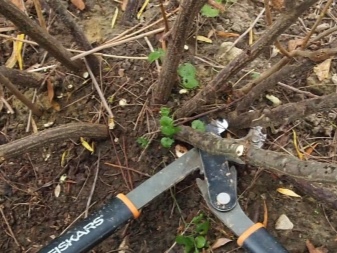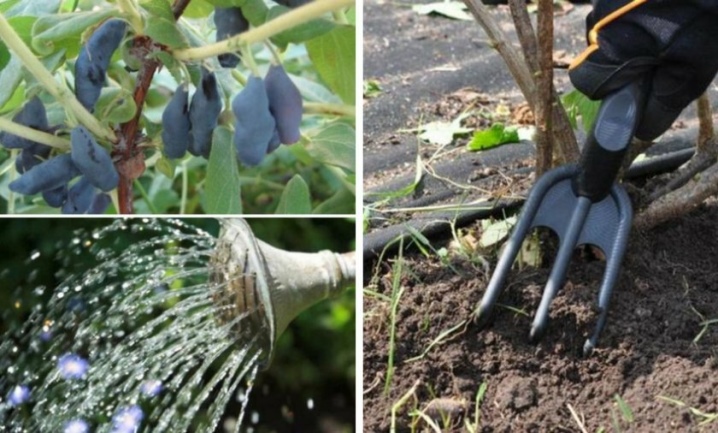All about spring care for honeysuckle

Beautiful perennial honeysuckle is created to delight the gardener's eye. The plant looks great in gardens and summer cottages, and its edible varieties produce fruits rich in vitamins and minerals. The culture requires minimal care, but in the spring it will need increased attention from the summer resident.


Pruning features
Spring care is extremely important for the shrub, because this is the time of awakening, the beginning of sap flow. Honeysuckle is surprisingly hardy, it can withstand even the most severe frosts. The plant begins to wake up very early, so the work will have to start earlier than with other crops. The main part of the start-up period is pruning after winter.
It is worth considering that plants that are less than three years old are not pruned. It is harmful for them, there will be no result.
But those that have already reached the age of three must be cut off. Open field pruning starts at the end of March. The last term is the first days of April, then the kidneys will begin to wake up. It is important that the air temperature is at least -5 degrees.
During pruning, it is imperative to remove branches that have frozen or dried up during the winter. It will no longer be possible to restore them. In addition, it is necessary to remove the bottom row, which spreads along the ground. This type of pruning is usually delayed for 2 seasons. In the first year, the shoots that are 30-40 cm higher than the soil are shortened.
In the next season, 50% of the branches that have developed in a year are pruned. It is important to take into account that it is impractical to remove skeletal branches to the point of growth, because this way the shrub will not be able to quickly recover. In addition, it is forbidden to cut off the upper part, since it is she who is responsible for the formation of flowers. After trimming, all the cuts are covered with garden varnish.
Important: if pruning failed in early spring, then you will have to wait for the next season. Otherwise, you can destroy the plant.


Treatment against diseases and pests
Honeysuckle has been shown to have an amazing ability to resist attacks from diseases and parasites, but it will still be better if you process it in the spring. First, consider what needs to be done to prevent or cure diseases.
-
Frost breakers... This ailment manifests itself immediately after winter, characterized by the presence of cracks on the trunk in which the fungus lives. Damaged specimens are removed, and the plant is sprayed with Bordeaux liquid.

-
Tuberculariosis... The disease causes the appearance of bumps on the plant. Then they lead to weakness and death. To avoid the disease, it is necessary to spray with copper oxychloride.

-
Blackening of the branches... A dangerous fungal disease leading to the death of branches. You can prevent it by treating the bushes in spring with Bordeaux liquid.

-
Powdery mildew. One of the most popular diseases. But it is easy to prevent it. For this, plants can be watered with boiling water. True, this should only be done with dormant shrubs, otherwise the culture will receive great stress. Another option for prevention is treatment with iron sulfate (before bud break).

- Ramulariasis... Because of this ailment, brown spots appear on the plant. Soon, the culture weakens its immunity, and disorders appear inside the tissues. Prevention - spraying honeysuckle with a 1% solution of copper sulfate with the addition of soap. The same treatment will help with cercosporosis.

These are the main ailments that can be prevented in the spring. But no less important will be preventive treatment against pests. For example, elderberry helps with aphids. The branches of this plant just need to be spread over the surface of the soil. Ticks can be prevented if the culture is sprayed from time to time with infusions of herbs with a strong odor. You can take garlic, onion, wormwood. Tobacco dust, which needs to be scattered on a bush or soil, also helps well.

If last year the honeysuckle was attacked by any insect, and it was not possible to get rid of it completely, it is better to use insecticides in early spring. The following remedies will be effective against most pests:
- "Confidor";
- Fitoverm;
- Actellik;
- Aktara;
- Inta-Vir.
It is recommended to use "Karbofos" against ticks.

Top dressing
In order for honeysuckle to grow healthy and produce consistently yields, it will need several dressings in the spring. So, before the start of flowering in the country, you can use organic matter. In March or April, it is recommended to put 5 kg of compost under each shrub. But this should be done only once every 3 years, this is quite enough.
With regard to annual organic fertilizers, the use of manure or bird droppings can give excellent results. A kilogram of the selected product is bred in a five-liter bucket, and then the plants are watered. In addition, herbs can be used as organic matter, for example, nettle, wormwood, clover. They need to be crushed, filled by a third of the bucket, and poured on top with water. After a week, the concentrate will be ready. Before watering the honeysuckle, the fertilizer will need to be diluted with water at least half.

The garden culture also responds very well to mineral root dressing. It is best to make such complexes every 2 years. As a rule, gardeners choose formulations containing phosphorus and potassium. Phosphorus is taken 10 g per square meter, and potassium - 15. After applying top dressing, the land must be thoroughly loosened.
The source of potassium is usually wood ash. And you can also take potassium nitrate, here the potassium content is even higher. Phosphorus is introduced in May, and this is usually bone meal. You will need 5 grams of product per square meter of soil. Sometimes Ammofoska is also used (10 g per 1 sq. M).

Foliar mineral dressing should be used if the culture is lagging behind in growth, poorly forming ovaries, and turning yellow.
To remedy the situation, you can use urea... The product is diluted in water according to the dosage, then you can spray it with honeysuckle. And you can also water the bushes with urea. To do this, stir 5 grams of the drug in a liter of clean water. In addition to urea, potassium sulfate and superphosphate are used for foliar dressing.

Useful Tips
As already mentioned, it is very important to properly care for the honeysuckle bushes in the spring. We examined the main stages of crop care. But it will be useful to add a few recommendations from experienced gardeners.
- Honeysuckle is great for growing in central Russia. It is quite simple to cultivate varieties in the Moscow region, but in Siberia, you will need to take into account some nuances. Due to the fact that the summer here is short, you need to manage to fertilize the crop as soon as possible so that it ripens earlier. Particular attention is paid to minerals. And you should do this: after dissolving the funds in water in the near-trunk circle, you need to dig a furrow. Top dressing is poured into it. So they are absorbed much better.
- Spring watering is very important for honeysuckle, especially if fertilized dry. With a lack of moisture, the plant will begin to dry, and top dressing will not be able to have the desired effect. Therefore, the soil should not be allowed to dry out.
- When applying top dressing, it is very important to keep the correct dosage. Honeysuckle belongs to those crops that tolerate excess nutrients very poorly. It is better to give a little less than to deal with the consequences of overfeeding later.
- Early spring digging of the soil is also a necessary stage of care.... If some pests have remained in the soil since the fall, then in the spring they can be destroyed. The main thing is not to dig too deep, so as not to damage the roots of the bushes.













The comment was sent successfully.